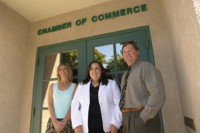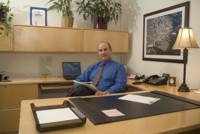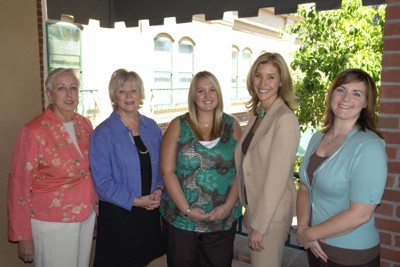Business Support Organizations Offer Both Local, Regional Focuses for Increasing Their Members' Success
Business Support Organizations Offer Both Local, Regional Focuses for Increasing Their Members' Success



In today's competitive business environment, it helps to have extra players on your team working in your best interest. The Tri-Valley has a number of such service organizations and, whether you're interested in advocacy, business development, or networking with other businesses, owning and operating a business here can be rewarding. The Pleasanton Chamber of Commerce, Tri-Valley Convention and Visitors Bureau, Pleasanton Downtown Association, Tri-Valley Business Council, East Bay Economic Development Alliance, and the Bay Area Council, can not only increase your ability to work more efficiently as a business but increase your business opportunities.
Pleasanton Chamber of Commerce
The Pleasanton Chamber of Commerce is an independent, non-profit, non-governmental corporation. With offices located at 777 Peters Avenue in Pleasanton, the Chamber currently boasts 900 member businesses and organizations. The organization provides networking and promotional opportunities for members and also helps shape the future of Pleasanton by providing input on public policy and economic development issues. The Chamber also offers a number of events where people can meet others doing business in the Tri-Valley.
"Pleasanton is widely recognized as a premier community in which to live and do business," notes David Bouchard, president and CEO. Pleasanton businesses contribute over 60 percent of the tax base and are the economic engine that produces the jobs, incomes and investments that support an extraordinary quality of life. "Members of the business community are also the people who reside, work and shop in Pleasanton. Accordingly, we believe that business has an important place in efforts to maintain and improve Pleasanton."
The Chamber is passing a milestone this year as it reaches its 60th year of incorporation.
"As we enter our 60th year, we're not only taking this opportunity to reflect on what the Pleasanton Chamber has achieved, to celebrate what we have done for our community; we're also looking forward to another 60 years of growth and prosperity for our businesses and our community."
For more information about the Pleasanton Chamber of Commerce (www.pleasanton.org), contact David Bouchard at (925) 846-5858 or david@pleasanton.org.
Hacienda businesses may also benefit from membership in nearby chambers of commerce as well. The Dublin Chamber of Commerce (www.dublinchamberofcommerce.org, 925/828-6200), Livermore Chamber of Commerce (www.livermorechamber.org, 925/447-1606), and San Ramon Chamber of Commerce (www.sanramon.org, 925/242-0600) each offer a variety of opportunities for business to business networking, community involvement, and advocacy.
Tri-Valley Convention & Visitors Bureau
The Tri-Valley Convention & Visitors Bureau (CVB) is the destination marketing organization for the cities of Pleasanton, Livermore, Dublin, and San Ramon, as well as the surrounding region. The organization promotes the Tri-Valley area as a preferred destination for visitors, meetings, and events by promoting CVB member businesses and bringing overnight visitors to the region. Its mission is to run an effective business that increases awareness of and measurable spending to the Tri-Valley region.
To do this, the CVB generates and tracks sales leads in nine key market segments to bring large groups into the Tri-Valley area for meetings and events with overnight stays. The CVB provides these visitors with information about dining, shopping, services, transportation, and attractions. In its last fiscal year, the CVB generated more than $4.5 million in economic impact for the Tri-Valley region, a 13 percent increase over the prior year, and booked more than 9,500 hotel room nights, a 9 percent increase over its last year.
The CVB, which was previously funded primarily through city grants, has recently created the new, multi-jurisdictional Tri-Valley Tourism Business Improvement District (TBID) based on assessed hotel room nights. A $1 per paid, occupied room night assessment is now levied at the 36 hotel properties in Pleasanton, Livermore, Dublin, and San Ramon that have at least 35 or more rooms available for public occupancy. This new funding mechanism allows the CVB to be a nearly self-funding organization and links the performance of its sales efforts to its funding, yet still allows for a public/private partnership with the cities its represents. The CVB also expects its annual budget to grow from $600,000 to nearly $1,000,000, depending on hotel occupancy levels.
The CVB develops and maintains communication with its 333 members and four partner cities to keep them informed and enthusiastic about the economic contribution of the CVB, editorial coverage for the region, Bureau events, programs and services, member news, as well as general trends and information. The Bureau's goal of increased outreach for itself, its members, and the Tri-Valley was evidenced by the 36 press mentions it received last fiscal year, which account for nearly $86,000 in advertising equivalency and 1.5 million impressions.
Members and potential members are invited to attend CVB events, including its annual Membership Meeting & Luncheon, Tri-Valley Regional Mixer, and new Event & Meeting Services Showcase. Members receive a free listing on the organization's website, as well as in the Bureau's newly expanded Tri-Valley Visitors Guide, an annual publication which promotes the Tri-Valley as a premier destination. The Bureau distributes 75,000 copies of the guide to Bay Area airports, California State Welcome Centers, AAA, at regional and national trade shows, and through its visitor center. "The Guide" offers recommendations for meetings and accommodations, dining, attractions, golf, wineries, galleries, shopping and services, and has a monthly calendar of events for Pleasanton, Livermore, Dublin, and San Ramon.
With all the recent change and growth, Amy Blaschka, the CVB's president and CEO, is enthusiastic for the future. "We're thrilled to provide both quantitative and qualitative benefits to our members and partners. We look forward to another record year of producing increased economic impact and awareness of the Tri-Valley region."
The Tri-Valley Convention & Visitors Bureau recently moved to larger office space to accommodate its growing staff. The CVB is located at 349 Main Street, Suite 203 in downtown Pleasanton. For more information, call the CVB at (925) 846-8910 or visit www.trivalleycvb.com.
Pleasanton Downtown Association
Downtown Pleasanton is home to more than 60 unique retail shops, 45 restaurants and 400 businesses offering personal and professional services. In 1984, the City Council recognized this special business area with the creation of the Pleasanton Downtown Association (www.pleasantondowntown.net). The Pleasanton Downtown Association's organizational mission is to promote the economic vitality and hometown character of downtown Pleasanton. Operating as an assessment district, it functions as a non-profit organization with funding provided by member assessments, matching city funds, sponsorships, associate memberships and revenue-producing events.
As a Main Street Community, the PDA is organized under a four-point strategy that incorporates the elements of organization, economic restructuring, promotion, and design or physical appearance. Successful implementation of this strategy involves a mutual effort by the PDA staff, business owners, property owners, associate members, and community volunteers. The organization's web site currently lists over 720 businesses doing business in the region. There are opportunities for businesses outside the Downtown area to become associate members and to be recognized through sponsorship of community events.
Membership in the Downtown Association is not limited to businesses with downtown locations. The PDA's Associate Membership program allows local businesses located outside the downtown district to support downtown Pleasanton while taking advantage of a variety of marketing opportunities. Associate Members are listed on the PDA web site with a description of their business and a link to their web site. This information is also included in the downtown business directory which is distributed throughout the valley. Associate Members are also entitled to attend the PDA's quarterly membership mixers and receive an invitation to the Annual Membership Dinner. Finally, PDA Associate members receive priority notification to participate in PDA sponsored events at a discounted rate.
The PDA is located at 830 Main Street, Suite A in Pleasanton and can be contacted at (925) 484-2199 or via email at info@pleasantondowntown.net.
Tri-Valley Business Council
The Tri-Valley Business Council (www.trivalley.org) is an organization involved in the regional issues that impact the quality of life and economic vitality of the Tri-Valley region. The council focuses on the cities of Livermore, Pleasanton, Dublin, San Ramon, and the town of Danville, as well as the portions of Alameda County and Contra Costa County that relate to the region. Founded in 1994, the Tri-Valley Business Council's board of directors consists of local corporate executives from institutions familiar to the community including Pacific Gas & Electric, Lawrence Livermore National Laboratory, and the ValleyCare Health System.
The Council recently has made progress in a number of key areas which are part of its core mission. One of the most important accomplishments, according to Tobias Brink, who recently succeeded Tom O'Malley as the organization's president, is the completion of the Tri-Valley Innovation Network study. "The study came up with a series of recommendations which I think are essential to the success of the Tri-Valley Business Council and the Tri-Valley business community as a whole. Those focus on three areas: regional economic strategies toward building an innovation network; a regional branding and marketing campaign; and also looking at the region's quality of life, particularly with respect to housing and transportation issues," he says. "It's particularly pertinent because the Contra Costa Times just published an article where they ranked Silicon Valley as number 12 of the major technology hubs in the United States, and it's ranking fell in part due to the high cost of housing and transportation issues such as congestion. I think there's an opportunity here for the Tri-Valley to build a foundation to position ourselves for inclusion on future lists of top U.S. tech regions."
As another part of that goal, the Council has been a key player in establishing the Port to Port Coalition, which has united the cities and other entities along the I-580 corridor. "Assuming that the state bond measure passes in November, this ensures that the region has some lobbying power behind it to secure funds to build HOV lanes and to look at the movement of goods from the Port of Oakland, over the Altamont Pass, and into the Central Valley. That's certainly a key initiative from a lobbying and quality of life standpoint. Anything that can be done to ease the movement of goods from the Port of Oakland to the Central Valley is going to be a priority."
For more information about the Tri-Valley Business Council contact Tobias Brink at (925) 227-1824 or tbrink@trivalley.org.
East Bay Economic Development Alliance
In September 1990, Alameda County established the East Bay Economic Development Alliance (www.eastbayeda.com; formerly known as EDAB) to enhance the competitive economic position of the County and its 14-member municipalities. The program is a public-private partnership funded by the county, cities, special districts, labor, and the private sector. The program's principal focus is on business investment and retention, regulatory coordination, networking, science, and technology. In 1996, the organization's service area was expanded to some of the cities in Contra Costa at their request. The EDA's mission is to improve the East Bay business climate by developing and maintaining resources, businesses, good jobs, and a high quality of life.
"What we do is fill a niche between city economic development efforts and, say, the state economic development effort," says Robert Sakai, the organization's Technology & Trade director. "The cities of course market themselves but many times there are issues that are more at the regional level, for instance, jobs and housing and movement of goods. We have worked a lot on those types of issues."
In the area of business development and promotion, the EDA works to streamline the regulatory process by working with local and regional agencies, as well as working toward international trade agreements. The organization is also involved in workforce development by sponsoring a number of studies with industry that are intended to improve the responsiveness and agility of government and training to meet the workforce and business needs of the region. A third area in which the EDA is active is as a vehicle or forum for addressing regional issues, the most recent of which are jobs/housing balance and an alternative analysis looking at goods movement within the region.
"If you just take an individual city, you can't make the same case that you can for the East Bay as a region," adds Sakai. "The East Bay in aggregate has tremendous resources, and when you point those out to people in Japan or the trade delegations that come from China or Germany or Scotland, they're impressed. Our point is to sell the Bay Area and once they're hooked on the Bay Area, then we tell them the role of the East Bay: we supply a significant part of the work force that works in Silicon Valley and in San Francisco, and we also have almost 40 percent of the future potential housing stock for that workforce. We are also the conduit for all the Central Valley labor that comes into the Bay Area, which means that a lot of companies have moved substantial facilities over here to retain the workers that they already have who come from the Central Valley or elsewhere in the East Bay, and, if they're in growth mode, to attract more workers coming out of the Central Valley. If you can build a case for the Bay Area, then you can build a good case for the East Bay. If they get sold on the East Bay, then they can decide which city they want to be in, in the East Bay."
For more information about the EDA, call the organization's information line at (510) 272-3874 or call Bruce Kern, executive director, at (510) 272-3874.
Bay Area Council
Founded in 1945, the Bay Area Council (www.bayareacouncil.org) is a business-sponsored, CEO-led, public-policy organization that develops and drives regional initiatives and critical infrastructure issues. Led by CEOs, the Bay Area Council presents a strong, united voice for hundreds of the largest employers in the Bay Area region whom employ more than 495,000 workers, or one of every six private sector employees in the Bay Area. The organization works to address several key issues including the region's position in the global economy, transportation, housing, energy policy, environmental quality, education, information technology, and water policy.
On its own, and partnering with economic development organizations, community groups, and government officials, the BAC works to solve problems that impact the business community in the region. It is funded through membership subscriptions with annual dues based on company size, headquarters, and the nature of the business.
"The BAC has had some notable success lately," says John Grubb, vice president of communications for the BAC. "The Council lobbied hard for the California Institute for Regenerative Medicine, or Stem Cell Institute, to be headquartered in the Bay Area, and won. In 2005, the Bay Area Council took the lead among California business associations in advocating for Proposition 42 gas tax monies to be used for transportation, and won. The Council played a strong role in preserving leadership in the state legislature for the Bay Area by helping Senator Perata of Oakland in his election as the President pro Tempore or leader of the state senate. In the past, one of our biggest claims to fame is the BART system, for which the BAC conceived of the idea, wrote the legislation, pushed it through the state legislature, and got the governor to sign off on. Later we helped fund it."
Continued Grubb, "In addition to the advocacy, many members appreciate the opportunity to meet and work with their senior level peers. One of the things that we think sums up the BAC is that our members are men and women of great power, but with that power comes responsibility. The BAC is a way to exercise that responsibility."
To inquire about membership in the BAC call (415) 981-6600 or email krobinson@bayareacouncil.org.
Photo: The staff of the Pleasanton Chamber of Commerce (top left); Jim Wunderman of the Bay Area Council (top right); Tri-Valley Convention & Visitors Bureau staff (below).
Also in this issue...
- Roche Diagnostics Breaks Ground on New Research Facility
- Sub-One Technology Moves Headquarters to Hacienda
- Business Bits
- Executive Profile: Nelson Hunter Puts His Finance Background to Good Use in the Commercial Travel Industry
- RossMorgan & Associates Makes Small Size Work in Big Ways
- J. Travis Photography Brings Digital Workflow to Product Promotion
- Business Support Organizations Offer Both Local, Regional Focuses for Increasing Their Members' Success
- Looking for IT Info, Education, Camaraderie? Try EBIG
- Hacienda Conducting Survey to Determine Transit Needs, Future Solutions
- Hope Hospice offers In-Home Care and Additional Services for Those at the End of Life
- Commuter Choice Transportation Fair
- Hacienda Index
- Calendar




